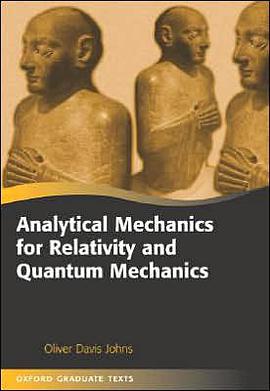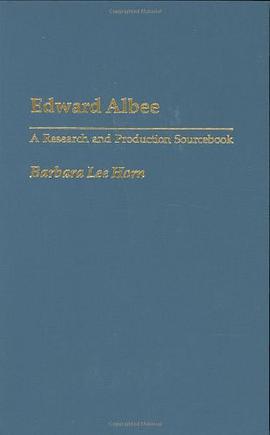
Analytical Mechanics for Relativity and Quantum Mechanics pdf epub mobi txt 电子书 下载 2025
- Analytical Mechanics
- Relativity
- Quantum Mechanics
- Classical Mechanics
- Theoretical Physics
- Physics
- Lagrangian Mechanics
- Hamiltonian Mechanics
- Advanced Physics
- Mathematical Physics

具体描述
This book provides an innovative and mathematically sound treatment of the foundations of analytical mechanics and the relation of classical mechanics to relativity and quantum theory. It is intended for use at the introductory graduate level. A distinguishing feature of the book is its integration of special relativity into teaching of classical mechanics. After a thorough review of the traditional theory, Part II of the book introduces extended Lagrangian and Hamiltonian methods that treat time as a transformable coordinate rather than the fixed parameter of Newtonian physics. Advanced topics such as covariant Langrangians and Hamiltonians, canonical transformations, and Hamilton-Jacobi methods are simplified by the use of this extended theory. And the definition of canonical transformation no longer excludes the Lorenz transformation of special relativity. This is also a book for those who study analytical mechanics to prepare for a critical exploration of quantum mechanics. Comparisons to quantum mechanics appear throughout the text. The extended Hamiltonian theory with time as a coordinate is compared to Dirac's formalism of primary phase space constraints.The chapter on relativisitic mechanics shows how to use covariant Hamiltonian theory to write the Klein-Gordon and Dirac equations. The chapter on Hamilton-Jacobi theory includes a discussion of the closely related Bohm hidden variable model of quantum mechanics. Classical mechanics itself is presented with an emphasis on methods, such as linear vector operators and dyadics, that will familiarize the student with similar techniques in quantum theory. Several of the current fundamental problems in theoretical physics - the development of quantum information technology, and the problem of quantizing the gravitational field, to name two - require a rethinking of the quantum-classical connection. Graduate students preparing for research careers will find a graduate mechanics course based on this book to be an essential bridge between their undergraduate training and advanced study in analytical mechanics, relativity, and quantum mechanics.
作者简介
目录信息
Dedication v
Preface vii
Acknowledgments ix
PART I INTRODUCTION: THE TRADITIONAL THEORY
1 Basic Dynamics of Point Particles and Collections 3
1.1 Newton’s Space and Time 3
1.2 Single Point Particle 5
1.3 Collective Variables 6
1.4 The Law of Momentum for Collections 7
1.5 The Law of Angular Momentum for Collections 8
1.6 “Derivations” of the Axioms 9
1.7 The Work–Energy Theorem for Collections 10
1.8 Potential and Total Energy for Collections 11
1.9 The Center of Mass 11
1.10 Center of Mass and Momentum 13
1.11 Center of Mass and Angular Momentum 14
1.12 Center of Mass and Torque 15
1.13 Change of Angular Momentum 15
1.14 Center of Mass and the Work–Energy Theorems 16
1.15 Center of Mass as a Point Particle 17
1.16 Special Results for Rigid Bodies 17
1.17 Exercises 18
2 Introduction to Lagrangian Mechanics 24
2.1 Configuration Space 24
2.2 Newton’s Second Law in Lagrangian Form 26
2.3 A Simple Example 27
2.4 Arbitrary Generalized Coordinates 27
2.5 Generalized Velocities in the q-System 29
2.6 Generalized Forces in the q-System 29
2.7 The Lagrangian Expressed in the q-System 30
2.8 Two Important Identities 31
2.9 Invariance of the Lagrange Equations 32
2.10 Relation Between Any Two Systems 33
2.11 More of the Simple Example 34
2.12 Generalized Momenta in the q-System 35
2.13 Ignorable Coordinates 35
2.14 Some Remarks About Units 36
2.15 The Generalized Energy Function 36
2.16 The Generalized Energy and the Total Energy 37
2.17 Velocity Dependent Potentials 38
2.18 Exercises 41
3 Lagrangian Theory of Constraints 46
3.1 Constraints Defined 46
3.2 Virtual Displacement 47
3.3 Virtual Work 48
3.4 Form of the Forces of Constraint 50
3.5 General Lagrange Equations with Constraints 52
3.6 An Alternate Notation for Holonomic Constraints 53
3.7 Example of the General Method 54
3.8 Reduction of Degrees of Freedom 54
3.9 Example of a Reduction 57
3.10 Example of a Simpler Reduction Method 58
3.11 Recovery of the Forces of Constraint 59
3.12 Example of a Recovery 60
3.13 Generalized Energy Theorem with Constraints 61
3.14 Tractable Non-Holonomic Constraints 63
3.15 Exercises 64
4 Introduction to Hamiltonian Mechanics 71
4.1 Phase Space 71
4.2 Hamilton Equations 74
4.3 An Example of the Hamilton Equations 76
4.4 Non-Potential and Constraint Forces 77
4.5 Reduced Hamiltonian 78
4.6 Poisson Brackets 80
4.7 The Schroedinger Equation 82
4.8 The Ehrenfest Theorem 83
4.9 Exercises 84
5 The Calculus of Variations 88
5.1 Paths in an N-Dimensional Space 89
5.2 Variations of Coordinates 90
5.3 Variations of Functions 91
5.4 Variation of a Line Integral 92
5.5 Finding Extremum Paths 94
5.6 Example of an Extremum Path Calculation 95
5.7 Invariance and Homogeneity 98
5.8 The Brachistochrone Problem 100
5.9 Calculus of Variations with Constraints 102
5.10 An Example with Constraints 105
5.11 Reduction of Degrees of Freedom 106
5.12 Example of a Reduction 107
5.13 Example of a Better Reduction 108
5.14 The Coordinate Parametric Method 108
5.15 Comparison of the Methods 111
5.16 Exercises 113
6 Hamilton’s Principle 117
6.1 Hamilton’s Principle in Lagrangian Form 117
6.2 Hamilton’s Principle with Constraints 118
6.3 Comments on Hamilton’s Principle 119
6.4 Phase-Space Hamilton’s Principle 120
6.5 Exercises 122
7 Linear Operators and Dyadics 123
7.1 Definition of Operators 123
7.2 Operators and Matrices 125
7.3 Addition and Multiplication 127
7.4 Determinant, Trace, and Inverse 127
7.5 Special Operators 129
7.6 Dyadics 130
7.7 Resolution of Unity 133
7.8 Operators, Components, Matrices, and Dyadics 133
7.9 Complex Vectors and Operators 134
7.10 Real and Complex Inner Products 136
7.11 Eigenvectors and Eigenvalues 136
7.12 Eigenvectors of Real Symmetric Operator 137
7.13 Eigenvectors of Real Anti-Symmetric Operator 137
7.14 Normal Operators 139
7.15 Determinant and Trace of Normal Operator 141
7.16 Eigen-Dyadic Expansion of Normal Operator 142
7.17 Functions of Normal Operators 143
7.18 The Exponential Function 145
7.19 The Dirac Notation 146
7.20 Exercises 147
8 Kinematics of Rotation 152
8.1 Characterization of Rigid Bodies 152
8.2 The Center of Mass of a Rigid Body 153
8.3 General Definition of Rotation Operator 155
8.4 Rotation Matrices 157
8.5 Some Properties of Rotation Operators 158
8.6 Proper and Improper Rotation Operators 158
8.7 The Rotation Group 160
8.8 Kinematics of a Rigid Body 161
8.9 Rotation Operators and Rigid Bodies 163
8.10 Differentiation of a Rotation Operator 164
8.11 Meaning of the Angular Velocity Vector 166
8.12 Velocities of the Masses of a Rigid Body 168
8.13 Savio’s Theorem 169
8.14 Infinitesimal Rotation 170
8.15 Addition of Angular Velocities 171
8.16 Fundamental Generators of Rotations 172
8.17 Rotation with a Fixed Axis 174
8.18 Expansion of Fixed-Axis Rotation 176
8.19 Eigenvectors of the Fixed-Axis Rotation Operator 178
8.20 The Euler Theorem 179
8.21 Rotation of Operators 181
8.22 Rotation of the Fundamental Generators 181
8.23 Rotation of a Fixed-Axis Rotation 182
8.24 Parameterization of Rotation Operators 183
8.25 Differentiation of Parameterized Operator 184
8.26 Euler Angles 185
8.27 Fixed-Axis Rotation from Euler Angles 188
8.28 Time Derivative of a Product 189
8.29 Angular Velocity from Euler Angles 190
8.30 Active and Passive Rotations 191
8.31 Passive Transformation of Vector Components 192
8.32 Passive Transformation of Matrix Elements 193
8.33 The Body Derivative 194
8.34 Passive Rotations and Rigid Bodies 195
8.35 Passive Use of Euler Angles 196
8.36 Exercises 198
9 Rotational Dynamics 202
9.1 Basic Facts of Rigid-Body Motion 202
9.2 The Inertia Operator and the Spin 203
9.3 The Inertia Dyadic 204
9.4 Kinetic Energy of a Rigid Body 205
9.5 Meaning of the Inertia Operator 205
9.6 Principal Axes 206
9.7 Guessing the Principal Axes 208
9.8 Time Evolution of the Spin 210
9.9 Torque-Free Motion of a Symmetric Body 211
9.10 Euler Angles of the Torque-Free Motion 215
9.11 Body with One Point Fixed 217
9.12 Preserving the Principal Axes 220
9.13 Time Evolution with One Point Fixed 221
9.14 Body with One Point Fixed, Alternate Derivation 221
9.15 Work–Energy Theorems 222
9.16 Rotation with a Fixed Axis 223
9.17 The Symmetric Top with One Point Fixed 224
9.18 The Initially Clamped Symmetric Top 229
9.19 Approximate Treatment of the Symmetric Top 230
9.20 Inertial Forces 231
9.21 Laboratory on the Surface of the Earth 234
9.22 Coriolis Force Calculations 236
9.23 The Magnetic – Coriolis Analogy 237
9.24 Exercises 239
10 Small Vibrations About Equilibrium 246
10.1 Equilibrium Defined 246
10.2 Finding Equilibrium Points 247
10.3 Small Coordinates 248
10.4 Normal Modes 249
10.5 Generalized Eigenvalue Problem 250
10.6 Stability 252
10.7 Initial Conditions 252
10.8 The Energy of Small Vibrations 253
10.9 Single Mode Excitations 254
10.10 A Simple Example 255
10.11 Zero-Frequency Modes 260
10.12 Exercises 261
PART II MECHANICS WITH TIME AS A COORDINATE
11 Lagrangian Mechanics with Time as a Coordinate 267
11.1 Time as a Coordinate 268
11.2 A Change of Notation 268
11.3 Extended Lagrangian 269
11.4 Extended Momenta 270
11.5 Extended Lagrange Equations 272
11.6 A Simple Example 273
11.7 Invariance Under Change of Parameter 275
11.8 Change of Generalized Coordinates 276
11.9 Redundancy of the Extended Lagrange Equations 277
11.10 Forces of Constraint 278
11.11 Reduced Lagrangians with Time as a Coordinate 281
11.12 Exercises 282
12 Hamiltonian Mechanics with Time as a Coordinate 285
12.1 Extended Phase Space 285
12.2 Dependency Relation 285
12.3 Only One Dependency Relation 286
12.4 From Traditional to Extended Hamiltonian Mechanics 288
12.5 Equivalence to Traditional Hamilton Equations 290
12.6 Example of Extended Hamilton Equations 291
12.7 Equivalent Extended Hamiltonians 292
12.8 Alternate Hamiltonians 293
12.9 Alternate Traditional Hamiltonians 295
12.10 Not a Legendre Transformation 295
12.11 Dirac’s Theory of Phase-Space Constraints 296
12.12 Poisson Brackets with Time as a Coordinate 298
12.13 Poisson Brackets and Quantum Commutators 300
12.14 Exercises 302
13 Hamilton’s Principle and Noether’s Theorem 305
13.1 Extended Hamilton’s Principle 305
13.2 Noether’s Theorem 307
13.3 Examples of Noether’s Theorem 308
13.4 Hamilton’s Principle in an Extended Phase Space 310
13.5 Exercises 312
14 Relativity and Spacetime 313
14.1 Galilean Relativity 313
14.2 Conflict with the Aether 315
14.3 Einsteinian Relativity 316
14.4 What Is a Coordinate System? 318
14.5 A Survey of Spacetime 319
14.6 The Lorentz Transformation 331
14.7 The Principle of Relativity 337
14.8 Lorentzian Relativity 339
14.9 Mechanism and Relativity 340
14.10 Exercises 341
15 Fourvectors and Operators 343
15.1 Fourvectors 343
15.2 Inner Product 346
15.3 Choice of Metric 347
15.4 Relativistic Interval 347
15.5 Spacetime Diagram 349
15.6 General Fourvectors 350
15.7 Construction of New Fourvectors 351
15.8 Covariant and Contravariant Components 352
15.9 General Lorentz Transformations 355
15.10 Transformation of Components 356
15.11 Examples of Lorentz Transformations 358
15.12 Gradient Fourvector 360
15.13 Manifest Covariance 361
15.14 Formal Covariance 362
15.15 The Lorentz Group 362
15.16 Proper Lorentz Transformations and the Little Group 364
15.17 Parameterization 364
15.18 Fourvector Operators 366
15.19 Fourvector Dyadics 367
15.20 Wedge Products 368
15.21 Scalar, Fourvector, and Operator Fields 369
15.22 Manifestly Covariant Form of Maxwell’s Equations 370
15.23 Exercises 373
16 Relativistic Mechanics 376
16.1 Modification of Newton’s Laws 376
16.2 The Momentum Fourvector 378
16.3 Fourvector Form of Newton’s Second Law 378
16.4 Conservation of Fourvector Momentum 380
16.5 Particles of Zero Mass 380
16.6 Traditional Lagrangian 381
16.7 Traditional Hamiltonian 383
16.8 Invariant Lagrangian 383
16.9 Manifestly Covariant Lagrange Equations 384
16.10 Momentum Fourvectors and Canonical Momenta 385
16.11 Extended Hamiltonian 386
16.12 Invariant Hamiltonian 387
16.13 Manifestly Covariant Hamilton Equations 388
16.14 The Klein–Gordon Equation 389
16.15 The Dirac Equation 390
16.16 The Manifestly Covariant N-Body Problem 392
16.17 Covariant Serret–Frenet Theory 399
16.18 Fermi–Walker Transport 401
16.19 Example of Fermi–Walker Transport 403
16.20 Exercises 405
17 Canonical Transformations 411
17.1 Definition of Canonical Transformations 411
17.2 Example of a Canonical Transformation 412
17.3 Symplectic Coordinates 412
17.4 Symplectic Matrix 416
17.5 Standard Equations in Symplectic Form 417
17.6 Poisson Bracket Condition 418
17.7 Inversion of Canonical Transformations 419
17.8 Direct Condition 420
17.9 Lagrange Bracket Condition 422
17.10 The Canonical Group 423
17.11 Form Invariance of Poisson Brackets 424
17.12 Form Invariance of the Hamilton Equations 426
17.13 Traditional Canonical Transformations 428
17.14 Exercises 430
18 Generating Functions 434
18.1 Proto-Generating Functions 434
18.2 Generating Functions of the F1 Type 436
18.3 Generating Functions of the F2 Type 438
18.4 Examples of Generating Functions 439
18.5 Other Simple Generating Functions 441
18.6 Mixed Generating Functions 442
18.7 Example of a Mixed Generating Function 444
18.8 Finding Simple Generating Functions 445
18.9 Finding Mixed Generating Functions 446
18.10 Finding Mixed Generating Functions—An Example 448
18.11 Traditional Generating Functions 449
18.12 Standard Form of Extended Hamiltonian Recovered 451
18.13 Differential Canonical Transformations 452
18.14 Active Canonical Transformations 453
18.15 Phase-Space Analog of Noether Theorem 454
18.16 Liouville Theorem 455
18.17 Exercises 456
19 Hamilton–Jacobi Theory 461
19.1 Definition of the Action 461
19.2 Momenta from the S1 Action Function 462
19.3 The S2 Action Function 464
19.4 Example of S1 and S2 Action Functions 465
19.5 The Hamilton–Jacobi Equation 466
19.6 Hamilton’s Characteristic Equations 467
19.7 Complete Integrals 469
19.8 Separation of Variables 472
19.9 Canonical Transformations 473
19.10 General Integrals 475
19.11 Mono-Energetic Integrals 480
19.12 The Optical Analogy 482
19.13 The Relativistic Hamilton–Jacobi Equation 483
19.14 Schroedinger and Hamilton–Jacobi Equations 483
19.15 The Quantum Cauchy Problem 485
19.16 The Bohm Hidden Variable Model 486
19.17 Feynman Path-Integral Technique 487
19.18 Quantum and Classical Mechanics 488
19.19 Exercises 489
PART III MATHEMATICAL APPENDICES
A Vector Fundamentals 495
A.1 Properties of Vectors 495
A.2 Dot Product 495
A.3 Cross Product 496
A.4 Linearity 496
A.5 Cartesian Basis 497
A.6 The Position Vector 498
A.7 Fields 499
A.8 Polar Coordinates 499
A.9 The Algebra of Sums 502
A.10 Miscellaneous Vector Formulae 502
A.11 Gradient Vector Operator 504
A.12 The Serret–Frenet Formulae 505
B Matrices and Determinants 508
B.1 Definition of Matrices 508
B.2 Transposed Matrix 508
B.3 Column Matrices and Column Vectors 509
B.4 Square, Symmetric, and Hermitian Matrices 509
B.5 Algebra of Matrices: Addition 510
B.6 Algebra of Matrices: Multiplication 511
B.7 Diagonal and Unit Matrices 512
B.8 Trace of a Square Matrix 513
B.9 Differentiation of Matrices 513
B.10 Determinants of Square Matrices 513
B.11 Properties of Determinants 514
B.12 Cofactors 515
B.13 Expansion of a Determinant by Cofactors 515
B.14 Inverses of Nonsingular Matrices 516
B.15 Partitioned Matrices 517
B.16 Cramer’s Rule 518
B.17 Minors and Rank 519
B.18 Linear Independence 520
B.19 Homogeneous Linear Equations 520
B.20 Inner Products of Column Vectors 521
B.21 Complex Inner Products 523
B.22 Orthogonal and Unitary Matrices 523
B.23 Eigenvalues and Eigenvectors of Matrices 524
B.24 Eigenvectors of Real Symmetric Matrix 525
B.25 Eigenvectors of Complex Hermitian Matrix 528
B.26 Normal Matrices 528
B.27 Properties of Normal Matrices 530
B.28 Functions of Normal Matrices 533
C Eigenvalue Problem with General Metric 534
C.1 Positive-Definite Matrices 534
C.2 Generalization of the Real Inner Product 535
C.3 The Generalized Eigenvalue Problem 536
C.4 Finding Eigenvectors in the Generalized Problem 537
C.5 Uses of the Generalized Eigenvectors 538
D The Calculus of Many Variables 540
D.1 Basic Properties of Functions 540
D.2 Regions of Definition of Functions 540
D.3 Continuity of Functions 541
D.4 Compound Functions 541
D.5 The Same Function in Different Coordinates 541
D.6 Partial Derivatives 542
D.7 Continuously Differentiable Functions 543
D.8 Order of Differentiation 543
D.9 Chain Rule 543
D.10 Mean Values 544
D.11 Orders of Smallness 544
D.12 Differentials 545
D.13 Differential of a Function of Several Variables 545
D.14 Differentials and the Chain Rule 546
D.15 Differentials of Second and Higher Orders 546
D.16 Taylor Series 547
D.17 Higher-Order Differential as a Difference 548
D.18 Differential Expressions 548
D.19 Line Integral of a Differential Expression 550
D.20 Perfect Differentials 550
D.21 Perfect Differential and Path Independence 552
D.22 Jacobians 553
D.23 Global Inverse Function Theorem 556
D.24 Local Inverse Function Theorem 559
D.25 Derivatives of the Inverse Functions 560
D.26 Implicit Function Theorem 561
D.27 Derivatives of Implicit Functions 561
D.28 Functional Independence 562
D.29 Dependency Relations 563
D.30 Legendre Transformations 563
D.31 Homogeneous Functions 565
D.32 Derivatives of Homogeneous Functions 565
D.33 Stationary Points 566
D.34 Lagrange Multipliers 566
D.35 Geometry of the Lagrange Multiplier Theorem 569
D.36 Coupled Differential Equations 570
D.37 Surfaces and Envelopes 572
E Geometry of Phase Space 575
E.1 Abstract Vector Space 575
E.2 Subspaces 577
E.3 Linear Operators 578
E.4 Vectors in Phase Space 580
E.5 Canonical Transformations in Phase Space 581
E.6 Orthogonal Subspaces 582
E.7 A Special Canonical Transformation 582
E.8 Special Self-Orthogonal Subspaces 583
E.9 Arnold’s Theorem 585
E.10 Existence of a Mixed Generating Function 586
References 588
Index 591
· · · · · · (收起)
读后感
评分
评分
评分
评分
用户评价
相关图书
本站所有内容均为互联网搜索引擎提供的公开搜索信息,本站不存储任何数据与内容,任何内容与数据均与本站无关,如有需要请联系相关搜索引擎包括但不限于百度,google,bing,sogou 等
© 2025 book.quotespace.org All Rights Reserved. 小美书屋 版权所有




















